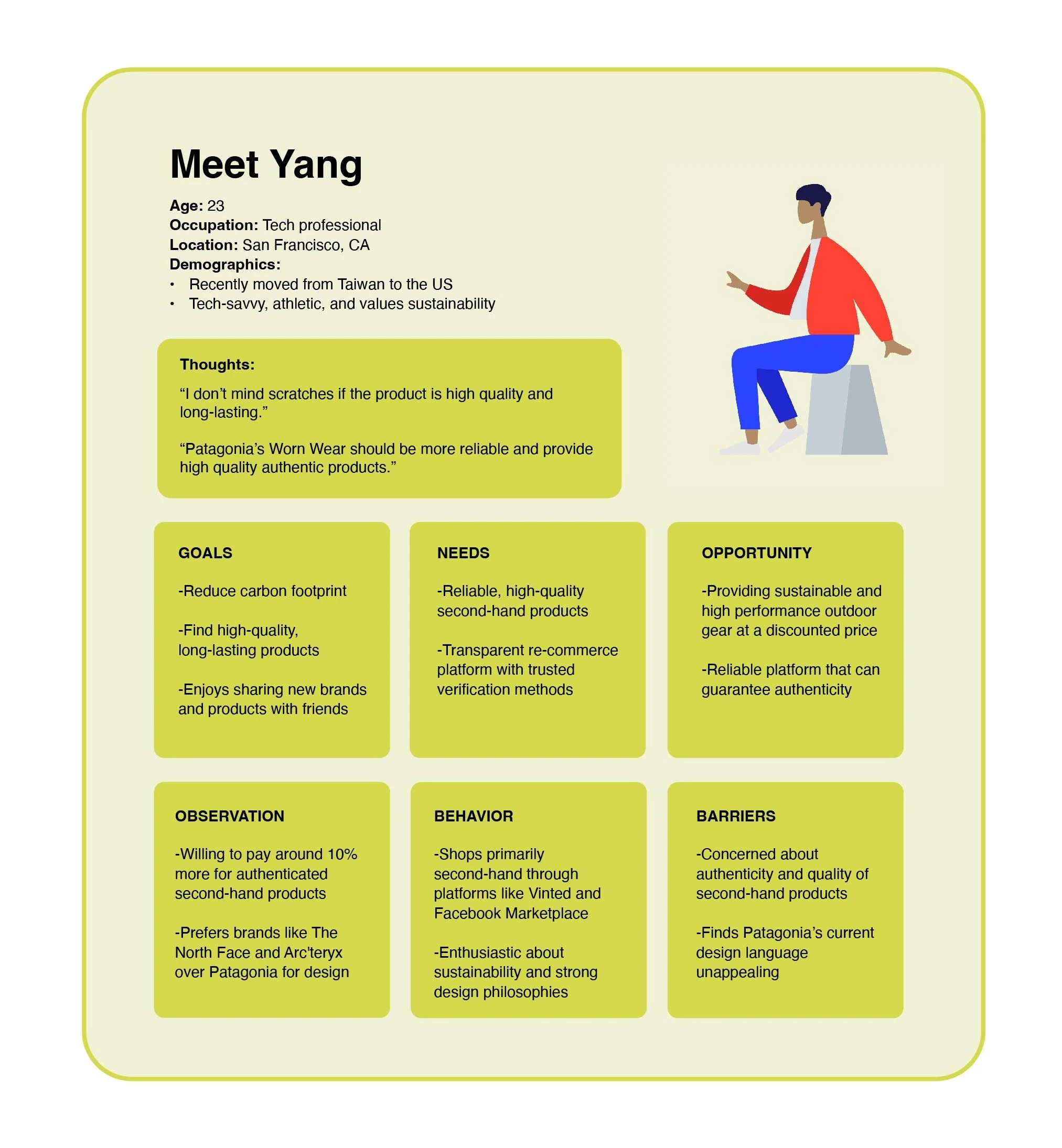Worn Wear: Patagonia’s re-commerce platform gets a revamp
The global secondhand apparel market is estimated to reach $350 billion in 2028.
Patagonia is joining the movement by directly selling its secondhand products. Worn Wear is a re-commerce platform founded by Patagonia, selling secondhand Patagonia products online.
Based on the data collected through extreme user interviews and an online survey, four personas were created to lay out the different needs and attitudes towards second-hand fashion and sustainability.
Customer Journey Mapping
To empathize with users and bring the personas to life, four customer journeys were mapped to identify pain and gain points.
As the demand for sustainability rises, brands and consumers seek to reduce their environmental impact. Many brands have created their own second-hand or re-commerce platforms. However, these direct resale platforms struggle to attract consumers and compete with established third-party platforms.This project explored direct re-commerce benefits and provided recommendations to improve the shopping experience for second-hand consumers.
Problem Statement:
How can Patagonia's Worn Wear appeal to US consumers aged 18-30 to promote responsible second-hand items consumption and encourage them to choose Worn Wear over other options such as brick & mortar shops and peer-to-peer platforms?
Primary Research
Opportunity: Offer monetary incentives to try online second-hand shopping by making it low risk
Rationale: Many consumers buy second-hand because of the lowered price, as seen through interview data. Additionally, discounts can incentivize consumers to take risks on new products.
Recommendations
1.Welcome Discount:
Implement a "Welcome to Worn Wear" campaign offering a 15% discount on the first purchase. Promote this through a prominent banner on the website and social media channels.
2. Giving Back:
Partner up with grass-root organizations, like the ones that Patagonia already work with, to give back on Earth Day and Black Friday. Rather than conventional sales that promote overconsumption, Patagonia could encourage consumers to donate to charities by providing discounts towards Worn Wear
Based on the insights gathered, the consumer interface was redesigned to address the concerns that consumers have towards buying second-hand online. It also provided room for detailed information that fit the uniqueness of selling second-hand online, which requires different information from Patagonia’s first hand products and main site.
The highlighted boxes indicate key changes that were made based on consumers’ pain points. These changes aim to alleviate consumer concerns and increase conversion and sales to Worn Wear.
Themes
To categorize the data and synthesize them into useful insights, themes were created after analyzing user journey, pain points, and opportunities.
Recommendations were created to help Worn Wear attract consumers by making the shopping experience more assuring and attractive.
Recommendations
Opportunity: Offer transparency on when the product came into Worn Wear and provide a detailed explanation of the selection process.
Rationale: Consumers are concerned of greenwashing. Additionally, around 42 percent of Gen Z consumers do not know what makes clothes sustainable (McKinsey, 2022) Providing thorough information on the garments' sourcing and production would also consumers to feel assured that the products are sustainable and trustworthy, just as advertised.
Recommendations
1. Product History:
Include a section on each product page, detailing when the item was initially sold, its usage duration, and when it entered the Worn Wear program.
2. Selection Process Explanation:
Create a detailed infographic or short video explaining how Patagonia selects and inspects Worn Wear items, highlighting the rigorous quality checks.
3. Explanation of Condition
Create a standardized condition rating system (e.g., Excellent, Good, Fair) with detailed criteria and example photos for each category.
4.Comprehensive Photo Gallery:
Ensure each product listing includes high-resolution photos from multiple angles. Include close-ups of any wear and tear. It’s essential to provide accurate photos for second-hand products. There could be interactive product demos, 360-degree views, videos, or AR to showcase products.
Opportunity for non-second hand consumer: Raise awareness for the positive impact of shopping second-hand.
Rationale: The survey conducted for this project shows 85% consumers wish to support sustainability but they don’t know where to start. Providing consumers with reliable
information will inform the practice of consuming more responsibly, and shows that brands are authentically reducing environmental footprint, rather than greenwashing, which many consumers wish to avoid.
Recommendations
1.Educational Campaigns:
Run educational campaigns emphasizing the environmental and economic benefits of buying second-hand. Use compelling statistics and success stories from satisfied Worn Wear customers.
2. Quality Assurance:
Highlight the stringent quality control processes and satisfaction guarantees to alleviate concerns about the condition and longevity of second-hand products.
3. Trial Period:
Offer a trial period where users can return items within a certain timeframe if they are not satisfied, reducing the perceived risk of buying second-hand.













